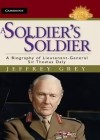A Soldier’s Soldier: A Biography of Lieutenant General Sir Thomas Daly
Written by: Jeffrey Grey,
Cambridge University Press, 2013,
ISBN 9781107031272, 264pp
Reviewed by: Lieutenant Adam Chirgwin
As author Jeffrey Grey observes in his opening to A Soldier’s Soldier: A Biography of Lieutenant-General Sir Thomas Daly, the Australian Army does not have a tradition of ‘great captains’. As a result, there is often a profound lack of knowledge and awareness of Australia’s leading military figures, both in society as a whole and within the Army itself. Grey seeks to redress this shortcoming in his examination of the life and career of the Vietnam-era Chief of the General Staff (CGS), Lieutenant General Sir Thomas Daly.
A Soldier’s Soldier is the first attempt to publish a biography of Daly. It covers his career from his arrival at the Royal Military College, Duntroon, in 1930 to his retirement as CGS in 1971 as Australia was preparing to withdraw from Vietnam. While his career is covered in its entirety, the major focus of the book is on Daly’s career following attainment of senior rank after his return to Australia from commanding the 28th Commonwealth Brigade in Korea. This was a transitional period for the Australian Army, characterised by expansion during the Vietnam War and the loss of public and political support resulting from that unpopular conflict. Particular attention is paid to Daly’s interaction with senior Navy and Air Force officers, politicians and senior foreign military officers. The book also examines structural change within the Army in which Daly played a major role, including developments in Army aviation and the pre-independence Pacific Islands Regiment.
The career of an officer such as Daly contains important lessons for professional development including how to effectively train and manage troops, regardless of rank. Daly possessed a signature command and leadership style that he applied throughout his career to great effect. His emphasis on soldier and family welfare was well received by both his peers and his subordinates, as the extensive range of interviews and personal accounts throughout the book attests. Examination of Daly’s command at all levels also provides valuable insight into effective unit training and management in times of affluence and austerity, and in both peace and war.
Daly’s struggle as CGS to lead an army that was undergoing significant structural change following an extensive operational deployment is also particularly topical for the current Australian Army in the aftermath of the withdrawal from Afghanistan and the changes heralded by the implementation of Plan Beersheba. Daly offers a strong example of how these challenges can be managed.
A Soldier’s Soldier is a comprehensive and well-balanced portrayal of a man who played a pivotal role in leading the Australian Army through a period of upheaval and uncertainty. The book analyses the broad range of pressures that Daly faced during his career; from managing subordinates and their families, to interservice, international and whole of government relations. While these pressures are common across every period in the history of the Australian Army, Daly’s actions warrant particular examination. His ability to maintain unity in the face of mounting public and government mistrust, and his efforts to promote trust and communication between the higher echelons of the Army and government, ensure that A Soldier’s Soldier is particularly pertinent to the contemporary Army. The author’s careful analysis of Daly’s command style at all levels also provides much that will benefit the current generation of Australian Army officers. A Soldier’s Soldier contains valuable lessons for current and future Australian soldiers as the Army once again enters a period of structural change following a lengthy operational commitment. The common elements lie not simply in the challenges faced, but more importantly in the way these are met.

